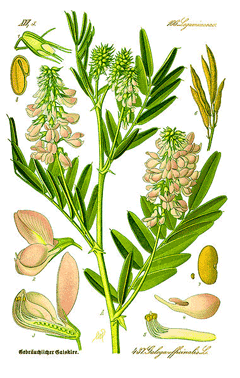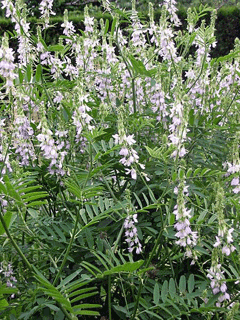 |
|
http://commons.wikimedia.org/wiki/File:Illustration_Galega_officinalis1.jpg |
 |
| http://fr.wikipedia.org/wiki/Utilisateur:Spedona |
Translate this page:
Summary
Physical Characteristics

 Galega_officinalis is a PERENNIAL growing to 1.2 m (4ft) by 0.8 m (2ft 7in) at a fast rate.
Galega_officinalis is a PERENNIAL growing to 1.2 m (4ft) by 0.8 m (2ft 7in) at a fast rate.
See above for USDA hardiness. It is hardy to UK zone 4. It is in flower from June to July, and the seeds ripen in August. The species is hermaphrodite (has both male and female organs) and is pollinated by Insects.
It can fix Nitrogen.
Suitable for: light (sandy), medium (loamy) and heavy (clay) soils and can grow in nutritionally poor soil. Suitable pH: mildly acid, neutral and basic (mildly alkaline) soils. It can grow in semi-shade (light woodland) or no shade. It prefers moist soil.
UK Hardiness Map
US Hardiness Map
Synonyms
G. bicolor. G. persica. G. tricolor.
Plant Habitats
Edible Uses
Leaves - cooked[2]. Used like spinach[177, 183]. Some caution is advised due to reports of possible toxicity. The herb is used as a substitute for rennet in curdling plant milks etc[183].
References More on Edible Uses
Medicinal Uses
Plants For A Future can not take any responsibility for any adverse effects from the use of plants. Always seek advice from a professional before using a plant medicinally.
Goat's rue was once important in the treatment of plague, fevers and infectious diseases[238]. It is still used in modern herbalism, though mainly for its effect in promoting milk-flow in lactating mothers (it has been shown to increase the flow of milk in cows and goats by 35 - 50%[4, 7, 238]) and for its positive effect on the digestive system[238]. The plant contains galegine, an alkaloid that strongly reduces blood sugar levels which make it useful in the treatment of diabetes[254]. The leaves and flowering tops are diaphoretic, diuretic, galactogogue and hypoglycaemic[4, 7, 21, 165]. It has also been used in the treatment of fevers[4, 7]. It is taken internally to treat insufficient lactation, late-onset diabetes, pancreatitis and digestive problems, especially chronic constipation caused by a lack of digestive enzymes[238]. The plant is harvested as it is just coming into flower and is dried for later use[4]. Some caution is advised, see notes above on toxicity.
References More on Medicinal Uses
The Bookshop: Edible Plant Books
Our Latest books on Perennial Plants For Food Forests and Permaculture Gardens in paperback or digital formats.

Edible Tropical Plants
Food Forest Plants for Hotter Conditions: 250+ Plants For Tropical Food Forests & Permaculture Gardens.
More

Edible Temperate Plants
Plants for Your Food Forest: 500 Plants for Temperate Food Forests & Permaculture Gardens.
More

More Books
PFAF have eight books available in paperback and digital formats. Browse the shop for more information.
Shop Now
Other Uses
A fast-growing plant, it makes a good green manure crop, enriching the soil with organic matter and also fixing atmospheric nitrogen[7]. The plant is used cosmetically in hand and foot bathes[7].
Special Uses
References More on Other Uses
Cultivation details
Succeeds in most soils but repays generous treatment[1, 200]. Prefers full sun and a deep moist soil[1, 4] but it also succeeds in light shade[200]. Grows well even in poor soils[233]. Plants are very tolerant of neglect and can be grown in quite coarse grass, which can be cut annually in the autumn[233, 238]. A long-lived plant[1], it can be invasive in good growing conditions[200]. This species has a symbiotic relationship with certain soil bacteria, these bacteria form nodules on the roots and fix atmospheric nitrogen. Some of this nitrogen is utilized by the growing plant but some can also be used by other plants growing nearby[200].
References Carbon Farming Information and Carbon Sequestration Information
Temperature Converter
Type a value in the Celsius field to convert the value to Fahrenheit:
Fahrenheit:
The PFAF Bookshop
Plants For A Future have a number of books available in paperback and digital form. Book titles include Edible Plants, Edible Perennials, Edible Trees,Edible Shrubs, Woodland Gardening, and Temperate Food Forest Plants. Our new book is Food Forest Plants For Hotter Conditions (Tropical and Sub-Tropical).
Shop Now
Plant Propagation
Seed - pre-soak for 12 hours in warm water and then sow the seed in spring or autumn in a cold frame[111, 200]. Spring-sown seed can be slow to germinate, a period of cold stratification may improve the germination time. When they are large enough to handle, prick the seedlings out into individual pots and plant them out into their permanent positions in the summer. If you have sufficient seed, then it is possible to sow outdoors in situ in mid to late spring. Division in spring or autumn[111]. Larger clumps can be replanted direct into their permanent positions, though it is best to pot up smaller clumps and grow them on in a cold frame until they are rooting well. Plant them out in the spring.
Other Names
If available other names are mentioned here
Native Range
TEMPERATE ASIA: Turkey TROPICAL ASIA: Pakistan (north) EUROPE: Czechoslovakia, Austria, Germany, Hungary, Poland, Former Yugoslavia, Albania, Bulgaria, Greece, Italy, Romania, Spain, France AFRICA: Algeria (north), Morocco
Weed Potential
Right plant wrong place. We are currently updating this section.
Please note that a plant may be invasive in one area but may not in your area so it’s worth checking.
Conservation Status
IUCN Red List of Threatened Plants Status :

Growth: S = slow M = medium F = fast. Soil: L = light (sandy) M = medium H = heavy (clay). pH: A = acid N = neutral B = basic (alkaline). Shade: F = full shade S = semi-shade N = no shade. Moisture: D = dry M = Moist We = wet Wa = water.
Expert comment
Author
L.
Botanical References
17200
Links / References
For a list of references used on this page please go here
Readers comment